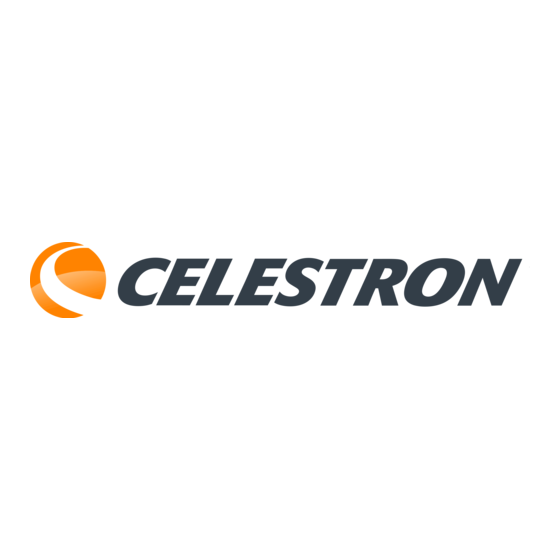Advertisement
Quick Links
Advertisement

Summary of Contents for Celestron 52291
- Page 1 C5 Spotting Scope - #52291 Instruction Manual...
- Page 2 All models have rugged, durable housings to give you a lifetime of pleasure with a minimal amount of maintenance. Your Celestron spotting scope is designed to give you hours of fun and rewarding observations. There are, however, a few things to consider before using your spotting scope that will ensure your safety and protect your equipment.
- Page 3 Assembly This section covers the correct set up and operating procedures for your Celestron C5 spotting scope and includes information on visual and photographic observations. The C5 spotting scope uses a combination of mirrors and lenses to produce an image. Such an optical system is known as a compound lens. This particular design, known as a Schmidt-Cassegrain, is one of the most compact and rugged optical systems on the market today.
- Page 4 The Eyepiece The eyepiece, or ocular, is the optical element that magnifies the image focused by the spotting scope. The eyepiece fits into either the visual back directly or the erect image diagonal. To install an ocular: 1. Loosen the thumbscrew on the star diagonal (or erect image diagonal) so it does not obstruct the inner diameter of the eyepiece end of the diagonal.
- Page 5 Once mounted on the photographic tripod, you are ready to use your C5 spotting scope. Following is pertinent technical information for the Celestron C5 spotting scope that you may find useful. •...
- Page 6 Moon) so that the image is visible even when out of focus. The Celestron C5 comes with a 6x30mm finder that helps in aiming at distant objects that are hard to find in the narrow field of the spotting scope. The first number used to describe the finder is the power while the second number is the diameter of the objective lens in millimeters.
- Page 7 power and has a 30mm objective lens. Incidentally, power is always compared to the unaided human eye. So an 8 power finder magnifies images eight times more than the human eye. To make the alignment process a little easier, you should perform this task in the daytime when it is easier to locate objects in the spotting scope without the finder.
- Page 8 You can change the power of your Celestron C5 spotting scope just by changing the eyepiece (ocular). To determine the magnification of your Celestron C5, simply divide the focal length of the spotting scope by the focal length of the eyepiece used.
- Page 9 1.04° by 52.5 produces a linear field width of 54.6 feet at a distance of one thousand yards. The apparent field of each eyepiece that Celestron manufactures is found in the Celestron Accessory Catalog (#93685). When working with any optical instrument, there are a few things to remember to ensure you get the best possible image.
- Page 10 If you have astigmatism, corrective lenses should be worn at all times. Your Celestron C5 can be used for both terrestrial and astronomical photography. Your C5 has a fixed aperture and, as a result, a fixed f/ratio. To properly expose your subjects photographically, you need to set your shutter speed accordingly.
- Page 11 Occasionally, you may experience dew build-up on the corrector plate of your C5 during an observing session. If you want to continue observing, the dew must be removed, either with a Celestron Lens Shade / Dew Cap or by pointing the spotting scope at the ground until the dew has evaporated.
- Page 12 (see figure 8-2). Center the de- focused star and notice in which direction the central shadow is skewed. Place your finger along the edge of the front cell of the telescope (be careful not to touch the corrector plate), pointing towards the collimation screws. The shadow of your finger should be visible when looking into the eyepiece.
- Page 13 In addition, perfect collimation delivers the optimal optical performance specifications that your telescope is built to achieve. If seeing (i.e., air steadiness) is turbulent, collimation is difficult to judge. Wait until a better night if it is turbulent or aim to a steadier part of the sky. A steadier part of the sky is judged by steady versus twinkling stars.
- Page 14 Used with any eyepiece, it doubles the magnification of that eyepiece. Celestron offers two Barlow lens in the 1-1/4" size for the C5. The 2x Ultima Barlow (#93506) is a compact triplet design that is fully multicoated for maximum light transmission and parfocal when used with the Ultima eyepieces.
- Page 15 (i.e. directly overhead). The resulting image is right side up, but will be reversed from left to right. T-Adapter (#93633-A) - T-Adapter (with additional T-Ring) allows you to attach your 35mm SLR camera to the rear cell of your Celestron C5. This turns...
- Page 16 This accessory is mandatory if you want to do photography through the telescope. Each camera make (i.e., Minolta, Nikon, Pentax, etc.) has its own unique mount and therefore, its own T-Ring. Celestron has 8 different models for 35mm cameras.
- Page 17 Celestron 2835 Columbia Street Torrance, CA 90503 U.S.A. Tel. (310) 328-9560 Fax. (310) 212-5835 Web site at http//www.celestron.com Copyright 2006 Celestron All rights reserved. (Products or instructions may change without notice or obligation.) Item #52291-INST 01-07 $10.00...








Need help?
Do you have a question about the 52291 and is the answer not in the manual?
Questions and answers